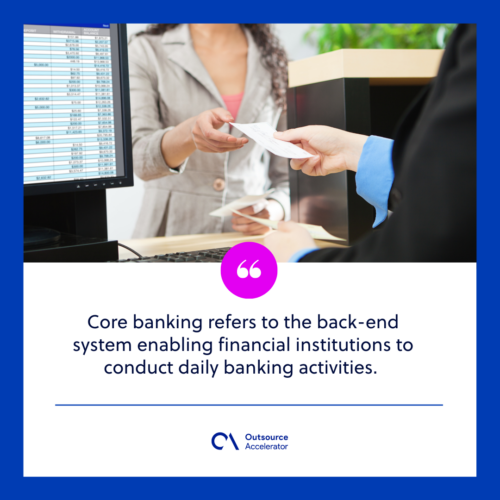Boosting business success with core banking systems

Core banking systems have revolutionized the way banks operate and move finances.
Managing finances has become crucial to success as the global market becomes more complex. Banks and other financial institutions are keeping up with transforming how finances move.
One of the most effective ways to achieve this goal is through implementing core banking systems. With this innovation, transactions between financial institutions and customers worldwide become easier without the hassles of transfer fees.
According to a report by Technavio, the global core banking software market is expected to reach USD 12.14 million by 2026. Apart from large banks, fintech companies join the competition in improving financial services through this system.
This article delves into core banking, how it works, and its undeniable benefits.
What is core banking?
Core banking refers to the back-end system enabling financial institutions to conduct daily banking activities. It forms the backbone of any bank or financial institution for various banking services such as deposits, withdrawals, loans, and transfers.

How core banking systems work
Core banking systems function through integrated software, hardware, and networking solutions. With this setup, customers can access banks as single entities, allowing them to transact from anywhere in the world.
They enable seamless communication between different branches and departments of a financial institution.
Once a deposit or transfer happens, the system sends a message to their data center to authorize the transaction. It then updates the transaction in real-time, reflecting changes to the customer’s account.
Types of core banking systems
Core banking systems are categorized based on the way they are handled. Below are the three types of core banking systems:
On-premise core banking systems
On-premise banking systems are installed and maintained locally on the bank’s servers. They offer high control and customization but require substantial upfront investment and ongoing maintenance costs.
Cloud-based core banking systems
Cloud banking systems are hosted on remote servers and accessed through the cloud infrastructure.
They provide greater flexibility, scalability, and cost-effectiveness, as banks can pay for the resources they use. It is also an attractive option for smaller financial institutions such as fintech companies.
Hosted core banking systems
Hosted core banking systems are a hybrid of on-premise and cloud-based systems. In this model, the core banking software is installed on the vendor’s servers, and the bank accesses it remotely.
Common characteristics of core banking systems
Core banking systems share common characteristics that enhance functionality and optimize business operations.
Here are some of the characteristics of a core banking system:
Virtual onboarding
One of the key features of modern core banking systems is virtual onboarding.
Virtual onboarding allows individuals to open new accounts remotely. This feature lets customers provide personal information, establish digital identities, and submit relevant documents online.
The efficient process ensures compliance with know your customer (KYC) and anti-money laundering (AML) regulations.
Single dashboard
Core banking systems often incorporate a single dashboard, providing a comprehensive view of a customer’s financial profile.
This dashboard aggregates data from various accounts and products, allowing customers and bank representatives to monitor transactions, account balances, and financial activities.
With this consolidated view, customers gain better control over their finances, and bank employees can offer personalized and tailored financial advice.

Transaction management
Efficient transaction management is a hallmark of core banking systems.
These systems ensure the smooth execution of operations for different transactions. It allows for better and more affordable processing of routine payments, fund transfers, or managing complex financial decisions.
Using secure and reliable channels guarantees that transactions are processed accurately and promptly, providing customers with peace of mind and bolstering their trust in the bank’s services.
Authentication
Core banking systems have robust authentication mechanisms to safeguard customer data and financial assets.
Multi-factor authentication, biometric verification, and token-based security are some of the techniques financial institutions apply to prevent unauthorized access and fraudulent activities.
In-app support
Modern core banking systems integrate in-app support to enhance customer experience and address queries promptly. Customers can seek assistance and receive immediate responses within the banking application through chatbots or instant messaging.
This feature streamlines the support process, reduces waiting times, and fosters a sense of customer satisfaction.
How core banking systems benefit businesses
Now that we have explored core banking and its common characteristics, let’s delve into its undeniable benefits to businesses.
Operational efficiency
Core banking systems automate mundane and time-consuming processes, such as manual data entry and reconciliation.
This automation enables financial institutions to focus on more value-added tasks and strategic initiatives.
Cost savings
By implementing a core banking system, financial institutions can significantly reduce costs associated with paper-based processes, manual errors, and redundant tasks.
The automation and digitization provided by these systems not only save time but also cut down on operational expenses.
Improved risk management
Core banking systems incorporate advanced risk management features that enable financial institutions to monitor and mitigate risks effectively.
Real-time updates and alerts help identify potential issues before they escalate, reducing the chances of financial losses or regulatory non-compliance.

Data-driven insights
Core banking systems generate a wealth of data that can be analyzed and leveraged to gain valuable insights. These insights can guide product development and customer segmentation, empowering financial institutions to stay competitive in a rapidly changing market.
Competitive advantage
Implementing a robust core banking system gives financial institutions a competitive edge in the market.
With better features, support, and overall experience, they can attract new customers, retain existing ones, and expand their market presence.







 Independent
Independent




